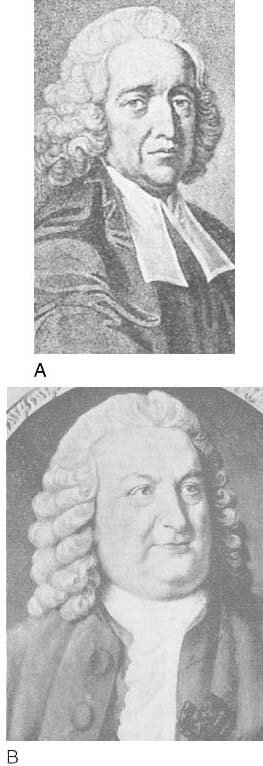 |
 |
Figure 1-3
Two scientists of the Enlightenment era. A,
Stephen Hales (1677–1761): detail of an oil painting by T. Hudson, 1759, in
the National Portrait Gallery, London. Hales was educated at Cambridge University,
England and was ordained as a minister in 1703. He spent his career as minister
to the parish of Teddington, England. His rudimentary studies on the gas produced
by mixing Walton pyrites (i.e., ferric disulfide) and spirit of nitre (i.e., nitric
acid) was the spark that prompted Priestley to pursue his studies on nitric oxide,
which led to the discovery of nitrous oxide in 1773. Hales was the first to measure
blood pressure and cardiac output. He also developed ventilators that brought fresh
air into prisons and granaries. B, Albrecht von Haller
(1708–1777): detail of an engraving by Ambroise Tardieu. Haller was born
in Bern, Switzerland. He served as professor of medicine and surgery at the University
of Göttingen, Germany, where he began his encyclopedic work, Physiological
Elements of the Human Body, published in eight volumes between 1757 and
1766. His demonstration that "irritability" was a property of muscle and "sensitivity"
was a property of nerves was derived from nearly 600 experiments on live animals.
He returned to Bern in 1753, and while there he published a catalog of the scientific
literature containing 52,000 references. (Portraits courtesy of the National
Library of Medicine, Bethesda, MD.)

 |
